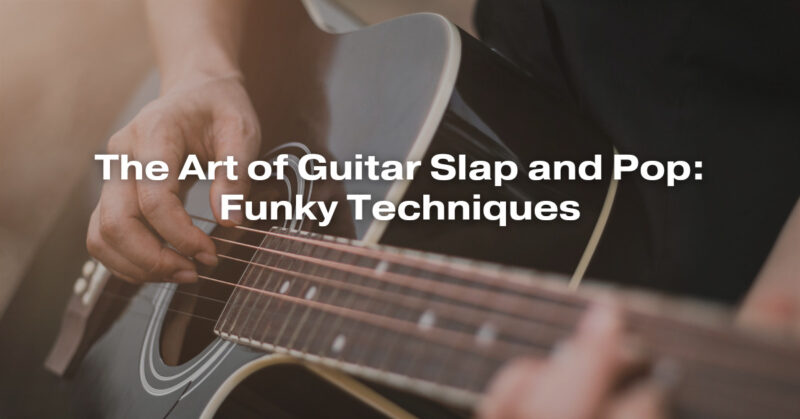Slap and pop guitar techniques are synonymous with funk and groove-driven music. Originating from bass guitar, these techniques have made their way into the guitar world, adding a unique rhythmic and percussive element to your playing. In this guide, we’ll explore the art of guitar slap and pop, offering tips and techniques to infuse funkiness into your guitar style.
Understanding Slap and Pop
Slap and pop are percussive techniques that involve striking and “popping” the strings with your fingers, creating sharp, rhythmic accents and vibrant tones. Here’s a breakdown of each technique:
1. Slap: The slap technique involves striking the strings with the fleshy part of your thumb, creating a percussive, muted sound. It’s typically performed on the lower (bass) strings.
2. Pop: The pop technique involves pulling or snapping a string with your index, middle, or ring finger. This creates a bright, snappy sound and is often used on the higher strings.
Tips for Slap Technique
1. Hand Position: Position your picking hand so your thumb hovers over the strings, ready to strike. Keep your fingers curled in, and your thumb should make contact with the string at a perpendicular angle.
2. Striking Motion: Use a controlled, snapping motion when slapping the strings. The thumb should strike the string and immediately rest on the adjacent lower string to mute it.
3. Muting: Muting is essential to keep unwanted string noise to a minimum. Rest your fretting hand lightly on the strings to mute them. Experiment with the placement of your palm to find the right amount of muting.
4. String Selection: Slap technique is often applied to the lower strings (E, A, and D). Experiment with different strings and combinations to create variations in your groove.
5. Dynamics: Vary the intensity of your slaps to create dynamics in your playing. Light slaps produce a softer sound, while heavy slaps add punch and aggression.
6. Practice Patterns: Work on different slap patterns, such as slap-and-pop grooves, double slaps, and triplets. Practice with a metronome to develop precision.
Tips for Pop Technique
1. Finger Placement: Position your fretting hand fingers over the strings you want to pop. You can use your index, middle, or ring finger, depending on your preference.
2. Snapping Motion: Execute the pop by snapping your finger against the string, pulling it away from the fretboard. The motion should be quick and snappy to produce a sharp note.
3. String Control: Control the direction and force of your pops to create the desired articulation. Experiment with up-pops and down-pops for different tonal variations.
4. Finger Strength: Building finger strength is crucial for powerful pops. Practice finger exercises and stretches to improve finger independence and strength.
5. String Gauge: Lighter gauge strings can make popping easier due to reduced string tension. Experiment with different string gauges to find your preferred feel.
6. Combine Slap and Pop: Integrate slap and pop techniques into a cohesive groove. Start with simple patterns and gradually incorporate more complex rhythms.
Practical Applications
Here are some practical ways to apply slap and pop techniques to your playing:
1. Grooves and Riffs: Create funky and rhythmically engaging grooves and riffs using slap and pop techniques. Experiment with different combinations of slaps and pops to craft unique patterns.
2. Chord Embellishments: Use pops to embellish chord progressions by adding percussive and melodic elements to your chords.
3. Solos and Melodies: Incorporate slap and pop techniques into your solos and melodies to add excitement and flair.
4. Rhythmic Accents: Use slaps and pops as rhythmic accents within your compositions to create dynamics and unexpected surprises.
5. Bass Lines: Experiment with playing bass lines on the guitar using slap and pop techniques, mimicking the sound of a bass guitar.
Conclusion
The art of guitar slap and pop brings a funky, rhythmic dimension to your playing. By mastering these techniques and incorporating them into your musical repertoire, you can infuse your guitar style with groove, energy, and percussive character. Remember that practice and experimentation are key to developing proficiency, so keep grooving and exploring new rhythmic possibilities with slap and pop guitar techniques.


